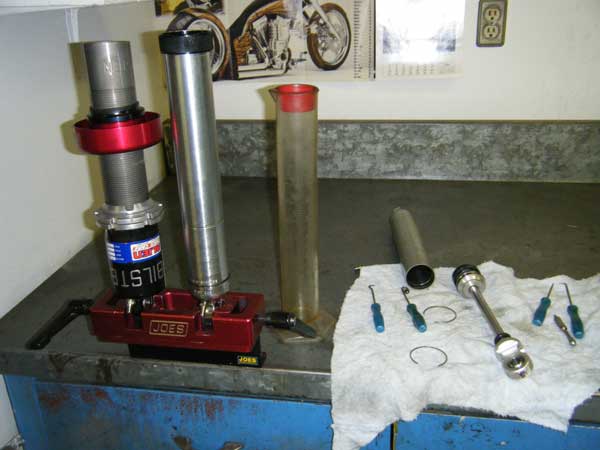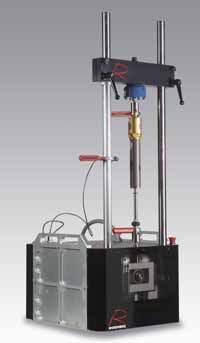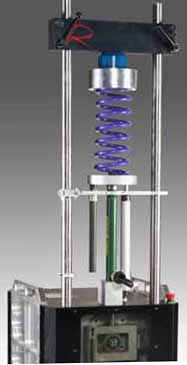A few notes about spring rating
It is highly recommended that all springs and shocks are rated before being put into service. The advantage of this is, you can establish a baseline so that after an accident, or if your car simply isn’t handling you can recheck your shocks or springs to see if they are the same or if something has changed.
If everything is the same then you can look elsewhere to find your handling problems.
 On a conventional spring-rater there are so many ways to get false ratings they are hardly worth using. Firstly most are designed to take the rate based on 1” of travel. That is wrong in itself as you need to know the rate throughout its whole travel not just one inch. If you use one of these machines you need to move it exactly 1” of travel to get the rate. How do you do this? With a tape measure or the ruler that is attached to the machine? If so you will get a totally inaccurate rating. The only way to know if you move it exactly 1” is if your machine uses a dial gauge or digital vernier caliper.
On a conventional spring-rater there are so many ways to get false ratings they are hardly worth using. Firstly most are designed to take the rate based on 1” of travel. That is wrong in itself as you need to know the rate throughout its whole travel not just one inch. If you use one of these machines you need to move it exactly 1” of travel to get the rate. How do you do this? With a tape measure or the ruler that is attached to the machine? If so you will get a totally inaccurate rating. The only way to know if you move it exactly 1” is if your machine uses a dial gauge or digital vernier caliper.

The other problem is the way the rate is displayed. Unless it has a digital read-out how do you know what rate it is? Do you look at the dial gauge that is in 50lb increments and take a reading? If so tap the gauge or move your head up or down and look at the gauge. You can get almost any rate you want. Even if you have a rater with a digital load cell and a proper way of measuring the stroke you still are only rating the spring in 1” of travel.
With a Spring Dyno you get the rate throughout its whole range of motion and can get the real rate of your spring. After testing many springs you’d be alarmed at what we have found. Most springs start off at one rate then as the spring collapses the rate skyrockets. This adversely effects your handling .The other issue is if you don’t really know what rate your spring is when you change it you don’t know if your increasing or decreasing your rates. The other issue is when you go to replace your spring with the same rate do to failure or damage. Are you really replacing it with the same rate? Spring rates are one thing that most racers are misinformed about and knowing and learning your springs will allow you to understand your suspension better and ultimately improve performance.
Spring and shock performance
The good thing about racing is racers are always trying to better themselves and improve performance. With the advent of shock and spring dynos the manufacturers are having to improve their products as more consumers are able to check to see if what they are getting is what they are paying for. For the longest time both shock and spring makers sent out products that you just had to believe what they told you as far as rate and performance. Unfortunately quite often it was a lot different than you were told. But how would you know? Racing is one thing where cheaper isn’t better. With shocks and springs the more expensive they are the better they perform. Buyer beware, you get what you pay for!


Why service your shocks?
Shocks are typically one of the most important parts of your car's handling but more often than not they are put on the car and run season after season without maintenance. All shocks have some form of a piston combined with some valving which creates rebound and compression dampening. There are varying other parts but the piston, the piston ring, and a small amount of oil are common to all shock absorbers.
The piston moves up and down at a high rate of speed in a small amount of oil, consequently the oil needs to be changed frequently. Additionally debri and moisture end up in the oil which causes contamination. In a racing shock, unlike a street shock, the manufacturers use a rod seal that has very low drag so as not to affect the valving. These low drag seals don't affect the valving but they do allow moisture and small amounts of dirt to pass thru into the oil. Every time the rod compresses it drags dirt past the seal, especially if there are nicks in the shaft, thus contamination of the oil occurs.
On a dirt track this is a real problem and creates oil contamination even quicker. As for moisture in your shock, that is very easy to explain. When the shocks function they get hot. As a matter of fact after a race they are so hot they can hardly be touched. In the atmosphere there is a lot of moisture. When the shocks cool they draw air (and moisture) past the seals, adding to contamination of the oil. Think about oil with moisture, it turns to a froth. When this happens with a shock, the valving dramatically changes.
If there is dirt or debris in the oil it can hold the valving shims or valves open causing oil to bypass, and again, the valving to change. The oil needs to be changed. Additionally some shock companies use a low quality oil to save money. Low quality oil breaks down with heat and changes viscosity, which changes valving characteristics. This may be a reason why your cars handling goes away as the race goes on. Plain and simple The oil needs to be changed. At Alien Race Cars we only use the highest quality oil available.
Oil should be changed yearly in a pavement application or twice as often if running dirt.